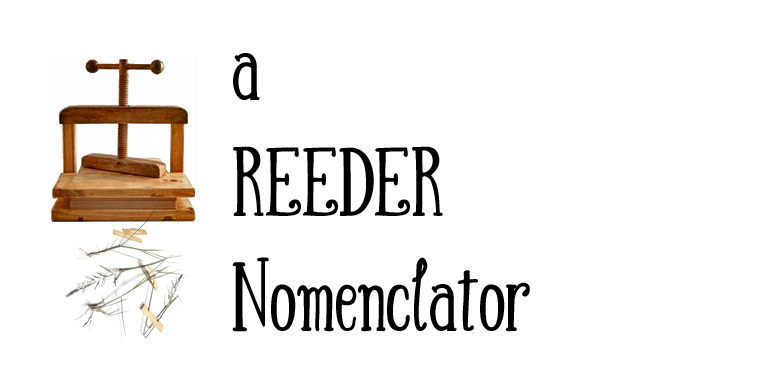Reeder, J.R. & C.G. Reeder. 1972. [book review] A Revised Flora of Malaya: An illustrated systematic account of the Malayan flora, including commonly cultivated plants, Vol. III-Grasses of Malaya, by H.B. Gilliland and H.M. Burkill. Bioscience 22: 324.
Reeder, J.R. & C.G. Reeder. 1973. [meeting abstract] Blepharidachne, an anomalous eragrostoid grass. Journal of the Colorado-Wyoming Academy of Science 7(4): 29.
Reeder, J.R. & C.G. Reeder. 1974. [meeting abstract] Publication date of Fournier's Mexicanas Plantas, Pars II. American Journal of Botany 61(supplement): 49.
Reeder, C.G. & J.R. Reeder. 1974. Publication date of Fournier's Mexicanas Plantas, Pars II. Taxon 23: 543-547.
Reeder, J.R. & C.G. Reeder. 1975. [meeting abstract] The Mexican grass genus Chaboissaea. American Journal of Botany 62(supplement): 58-59.
Reeder, J.R. & C. Reeder. 1978. Tragus racemosus in Arizona. Madroño 25: 107-108.
Reeder, J.R. & C.G. Reeder. 1978. [book review] Intermountain Flora—Vascular Plants of the Intermountain West, U.S.A. Vol. 6: The Monocotyledons, by Arthur Cronquist, Arthur H. Holmgren, Noel H. Holmgren, James L. Reveal & Patricia K. Holmgren. Bulletin of the Torrey Botanical Club 105: 241-243.
Reeder, C.G. & J.R. Reeder. 1980. Rediscovery of Orcuttia fragilis (Gramineae). Phytologia 46: 341-343.
Reeder, J.R. & C.G. Reeder. 1980. Systematics of Bouteloua breviseta and B. ramosa (Gramineae). Systematic Botany 5: 312-321.
Reeder, C.G. & J.R. Reeder. 1980. [book review] Flora of Baja California, by Ira L. Wiggins. Bulletin of the Torrey Botanical Club 107: 553-556.
Gould, F.W. & R. Moran (eds.). 1981. The grasses of Baja California. San Diego Society of Natural History Memoir 12. San Diego: San Diego Society of Natural History.
Reeder, C.G. Muhlenbergia, pp.67-78.
Reeder, C.G. & J.R. Reeder. 1981. [book review] A Flora of New Mexico, by William C. Martin & Charles R. Hutchins. Bulletin of the Torrey Botanical Club 108: 490-492.
Reeder, C.G. 1985. The genus Lycurus (Gramineae) in North America. Phytologia 57: 283-291.
Reeder, J.R. & C.G. Reeder. 1985. Notes on Arizona grasses. Desert Plants 7(1): 22-23.
Reeder, C.G. & J.R. Reeder. 1986. Agrostis elliottiana (Gramineae) new to Arizona and New Mexico. Phytologia 60: 453-458.
Reeder, C.G. & J.R. Reeder. 1988. Aneuploidy in the Muhlenbergia subbiflora complex (Gramineae). Phytologia 65: 155-157.
Reeder, J.R. & C.G. Reeder. 1988. Hilaria annua (Gramineae), a new species from Mexico. Madroño 35: 6-9.
Reeder, C.G. & J.R. Reeder. 1989. A further note on Agrostis elliotiana (Gramineae) in Arizona. Phytologia 67: 134-138.
Reeder, J.R. & C.G. Reeder. 1990. Bouteloua eludens: elusive indeed, but not rare. Desert Plants 10(1): 19-22, 31.
Reeder, C.G. & J.R. Reeder. 1991. [in memoriam] Jason Richard Swallen (1903-1991). Taxon 40: 697-698.
Davidse, G., M. Sousa Sánchez & A.O. Chater (eds.). 1994. Flora Mesoamericana, vol. 6: Alismataceae a Cyperaceae. Universidad Nacional Autónoma de México, Missouri Botanical Garden Press, and the Natural History Museum (London).
Pohl, R.W., C.G. Reeder & G. Davidse. Sporobolus, pp.273-276. [online]
Reeder, C.G. Muhlenbergia, pp.276-286. [online]
Reeder, C.G. & J.R. Reeder. 1995. The resurrection of a species: Muhlenbergia straminea (Gramineae). Phytologia 78: 417-427.
Martin, P.S., D. Yetman, M. Fishbein, P. Jenkins, T.R. Van Devender & R.K. Wilson (eds.). 1998. Gentry's Río Mayo plants: The tropical deciduous forest and environs of northwest Mexico. Tucson: University of Arizona Press.
Reeder, J.R. & C.G. Reeder. Poaceae, pp.498-520.
Stevens, W.D., C. Ulloa Ulloa, A. Pool & O.M. Montiel (eds.). 2001. Flora de Nicaragua, vol. 3: Angiosperma. Missouri Botanical Garden Monographs in Systematic Botany 85. St. Louis: Missouri Botanical Garden Press.
Reeder, C.G. Muhlenbergia, pp.2075-2078. [online]
Pohl, R.W., C.G. Reeder & G. Davidse. Sporobolus, pp.2133-2136. [online]
Barkworth, M.E., K.M. Capels, S. Long & M.B. Piep (eds.). 2003. Flora of North America north of Mexico, vol. 25: Magnoliophyta: Commelinidae (in part): Poaceae, part 2. New York and London: Oxford University Press.
Reeder, C. Lycurus, pp.200-203. [online]
Cartron, J.-L.E., G. Ceballos & R.S. Felger (eds.). 2005. Biodiversity, ecosystems, and conservation in northern Mexico. New York: Oxford University Press.
Van Devender, T.R., J.R. Reeder, C.G. Reeder & A.L. Reina-G. Distribution and diversity of grasses in the Yécora region of the Sierra Madre Occidental of eastern Sonora, Mexico, pp.107-121.
Barkworth, M.E., K.M. Capels, S. Long, L.K. Anderton & M.B. Piep (eds.). 2007. Flora of North America north of Mexico, vol. 24: Magnoliophyta: Commelinidae (in part): Poaceae, part 1. New York and London: Oxford University Press.
Additions, Corrections, and Comments (Flora of North America vol. 25): Spartina Schreb., p.791; Echinochloa P.Beauv., p.792.
Reeder, J.R. & C.G. Reeder. 2007. Two more alien grasses now at home in the continental U.S.A. Phytologia 89: 1-7.
Botanical publications by John Reeder, including with authors other than Charlotte
Reeder, J.R. 1943. The status of Distichlis dentata. Bulletin of the Torrey Botanical Club 70: 53-57.
Reeder, J.R. 1946. Notes on Papuasian Saxifragaceae. Journal of the Arnold Arboretum 27: 275-288.
Merrill, E.D. & J.R. Reeder. 1946. New plant names published by Amos Eaton between the years 1817 and 1840. Bartonia 24: 26-79.
Reeder, J.R. 1948. The Gramineae-Panicoideae of New Guinea. Journal of the Arnold Arboretum 29: 257-392 +pl. 1-7.
Reeder, J.R. 1950. New and noteworthy Graminiae from New Guinea. Journal of the Arnold Arboretum 31: 320-328.
Reeder, J.R. 1951. Setaria lutescens an untenable name. Rhodora 53: 27-30.
Reeder, J.R. 1951. A further note on Cercis canadensis in Connecticut. Rhodora 53: 246-247.
Reeder, J.R. 1951. A new species of Poa from Peru. Journal of the Washington Academy of Sciences 41: 295-296.
Reeder, J.R. & S.-Y. Cheo. 1951. Notes on Xanthoxylum & Fagara in China. Journal of the Arnold Arboretum 32: 67-72 +pl. 1-2.
Reeder, J.R. 1953. The embryo of Streptochaeta and its bearing on the homology of the coleoptile. American Journal of Botany 40: 77-80.
Reeder, J.R. 1953. Affinities of the grass genus Beckmannia Host. Bulletin of the Torrey Botanical Club 80: 187-196.
Reeder, J.R. & K. von Maltzahn. 1953. Taxonomic significance of root-hair development in the Gramineae. Proceedings of the National Academy of Sciences 39: 593-598.
Reeder, J.R. 1956. The embryo of Jouvea pilosa as further evidence for the foliar nature of the coleoptile. Bulletin of the Torrey Botanical Club 83: 1-4.
Reeder, J.R. 1956. Note on Echinochloa muricata. Rhodora 58: 331-332.
Row, H.C. & J.R. Reeder. 1957. Root-hair development as evidence of relationships among genera of Gramineae. American Journal of Botany 44: 596-601.
Reeder, J.R. 1957. The embryo in grass systematics. American Journal of Botany 44: 756-768.
reprinted in R. Ornduff (ed.). 1967. Papers on Plant Systematics. Boston: Little, Brown and Company: pp.52-64.
Reeder, J.R. & M.A. Ellington. 1960. Calamovilfa, a misplaced genus of Gramineae. Brittonia 12: 71-77.
Reeder, J.R. 1960. The systematic position of the grass genus Anthephora. Transactions of the American Microscopical Society 79: 211-218.
Bailey, D.L. (ed.). 1961. Recent Advances in Botany, from lectures & symposia presented to the IX International Botanical Congress, Montreal, 1959, vol. I. [Canada]: University of Toronto Press.
Reeder, J.R. The Natural Classification of the Gramineae (I.U.B.S. Symposium): Embryology: The grass embryo in systematics, pp.91-96.
Reeder, J.R. & H.F. Decker. 1961. [meeting abstract] Affinities of Stipa and Aristida. American Journal of Botany 48: 549.
Reeder, J.R. & K.J. Norstog. 1961. The status of Hierochloë nashii and its relationship to H. odorata. Bulletin of the Torrey Botanical Club 88: 77-84.
Reeder, J.R. 1962. The bambusoid embryo: a reappraisal. American Journal of Botany 49: 639-641.
reprinted in R. Ornduff (ed.). 1967. Papers on Plant Systematics. Boston: Little, Brown and Company: pp.65-67.
Reeder, J.R. 1965. [meeting abstract] Dioecy in the genus Bouteloua (Gramineae). American Journal of Botany 52: 650.
Reeder, J.R. 1965. The tribe Orcuttieae and the subtribes of the Pappophoreae (Gramineae). Madroño 18: 18-28.
Reeder, J.R. 1966. [meeting abstract] Validity of the monotypic tribe Jouveeae (Gramineae). American Journal of Botany 53: 635.
Löve, Á. (ed.). 1966. IOPB Chromosome Number Reports VI: contributions by J.R. Reeder. Taxon 15: 117.
Reeder, J.R. 1967. [meeting abstract] Validity of the tribe Spartineae (Gramineae). American Journal of Botany 54: 656.
Reeder, J.R. 1967. Notes on Mexican grasses VI: miscellaneous chromosome numbers [1]. Bulletin of the Torrey Botanical Club 94: 1-17.
Löve, Á. (ed.). 1967. IOPB Chromosome Number Reports XI: contributions by J.R. Reeder and J.R. Reeder & D.N. Singh. Taxon 16: 215-216.
Reeder, J.R. & D.N. Singh. 1967. Chromosome number in Calamovilfa. Bulletin of the Torrey Botanical Club 94: 199-200.
Reeder, J.R. 1967. Notes on Mexican grasses VII: new name for a dioecious endemic. Brittonia 19: 244.
Reeder, J.R. 1968. [meeting abstract] Systematic position of the genus Triniochloa (Gramineae). American Journal of Botany 55: 735.
Löve, Á. (ed.). 1968. IOPB Chromosome Number Reports XVI: contributions by J.R. Reeder & T.R. Soderstrom. Taxon 17: 203-204.
Reeder, J.R. 1968. Notes on Mexican grasses VIII: miscellaneous chromosome numbers, 2. Bulletin of the Torrey Botanical Club 95: 69-86.
Reeder, J.R. & D.N. Singh. 1968. Chromosome numbers in the tribe Pappophoreae (Gramineae). Madroño 19: 183-187.
Löve, Á. (ed.). 1969. IOPB Chromosome Number Reports XXII: contributions by J.R. Reeder, T.R. Soderstrom & C.E. Calderón. Taxon 18: 441-442.
Reeder, J.R. 1969. Las gramineas dioicas de México. Boletín de la Sociedad de Botánica de México 90: 121-126.
Reeder, J.R. 1970. [meeting abstract] Cytotaxonomy of Blepharoneuron. Journal of the Colorado-Wyoming Academy of Science 7(1): 37.
Reeder, J.R. & D.J. Crawford. 1970. [meeting abstract] Affinities of E[r]ioneuron and Munroa (Gramineae). American Journal of Botany 57: 752.
Reeder, J.R. 1971. Notes on Mexican grasses IX: miscellaneous chromosome numbers, 3. Brittonia 23: 105-117.
Reeder, J.R. 1972 [1971]. [meeting abstract] Cytotaxonomy of Spartina (Gramineae). Journal of the Colorado-Wyoming Academy of Science 7(2-3): 25.
Reeder, J.R. 1975. Symposium: "Evolution of Biotic Communities—The Grassland Biota" (First International Congress of Systematic and Evolutionary Biology, Boulder, Colo., 1973). Taxon 24: 51.
Reeder, J.R. 1976. Systematic position of Redfieldia (Gramineae). Madroño 23: 434-438.
Reeder, J.R. 1977. Chromosome numbers in western grasses. American Journal of Botany 64: 102-110.
Reeder, J.R. 1977. The "germination flap" in certain Gramineae. Madroño 24: 123-124.
Hammel, B.E. & J.R. Reeder. 1979. The genus Crypsis (Gramineae) in the United States. Systematic Botany 4: 267-280.
Reeder, J.R. 1980. Nomenclatural changes in Orcuttia (Gramineae). Phytologia 47: 221.
Reeder, J.R. 1981. The type locality of Orcuttia fragilis. Taxon 30: 308.
Reeder, J.R. 1981. (580) Proposal to conserve Centotheca (Gramineae). Taxon 30: 348-349.
Reeder, J.R. 1982. Systematics of the tribe Orcuttieae (Gramineae) and the description of a new segregate genus, Tuctoria. American Journal of Botany 69: 1082-1095.
Löve, Á. (ed.). 1984. Chromosome Number Reports LXXXII: contributions by J.R. Reeder. Taxon 33: 132-133.
Reeder, J.R. 1984. A new record for Schizachyrium semitectum in Mexico. Phytologia 55: 252.
Reeder, J.R. 1985. [book review] Grasses: A Guide to Their Structure, Identification, Uses and Distribution in the British Isles, by C.E. Hubbard & J.C.E. Hubbard. Taxon 34: 745.
Reeder, J.R. 1986. Mistaken identity in annual Eragrostis (Gramineae). Phytologia 60: 95-97.
Reeder, J.R. 1986. Another look at Eragrostis tephrosanthos (Gramineae). Phytologia 60: 153-154.
Reeder, J.R. 1986. Type specimen of Bouteloua ramosa Scribn. ex Vasey (Gramineae). Taxon 35: 149-153.
Reeder, J.R. & L.J. Toolin. 1987. Scleropogon (Gramineae), a monotypic genus with disjunct distribution. Phytologia 62: 267-275.
Reeder, J.R. & L.J. Toolin. 1988. Pappophorum philippianum (Gramineae) new to North America. Phytologia 64: 402-403.
Reeder, J.R. & L.J. Toolin. 1989. Notes on Pappophorum (Gramineae: Pappophoreae). Systematic Botany 14: 349-358.
Reeder, J.R. & R.S. Felger. 1989. The Aristida californica-glabrata complex (Gramineae). Madroño 36: 187-197.
Reeder, J.R. 1991. A new species of Panicum (Gramineae) from Arizona. Phytologia 71: 300-303.
Reeder, J.R. 1993. What is Aristida peruviana? Madroño 40: 266-267.
Hickman, J.C. (ed.). 1993. The Jepson manual: higher plants of California. Berkeley: University of California Press.
Reeder, J.R. Eragrostis, pp.1257-1258 [online]; Neostapfia [online], Orcuttia, pp.1276-1277 [online]; Tuctoria, p.1300 [online].
Reeder, J.R. 1994. Setaria villosissima (Gramineae) in Arizona: fact or fiction. Phytologia 77: 452-455.
Reeder, J.R. 1994. Stipa tenuissima (Gramineae) in Arizona—a comedy of errors. Madroño 41: 328-329.
Peterson, P.M. & J.J. Ortíz-Diaz. 1998. Allelic variation in the amphitropical disjunct Muhlenbergia torreyi (Poaceae: Muhlenbergiinae). Brittonia 50: 381-391.
Reeder, J.R. Appendix I: Chromosome counts of Muhlenbergia arenicola and M. torreyi, p.388.
Toolin, L. & J.R. Reeder. 2000. The status of Setaria macrostachya and its relationship to S. vulpiseta (Gramineae). Systematic Botany 25: 26-32.
Reeder, J.R. 2001. Chromosome number in Choisya (Rutaceae). Crossosoma 26: 12.
Reeder, J.R. 2001. Noteworthy collections: Setaria arizonica Rominger, Setariopsis auriculata (E. Fourn.) Scribner, Alopecurus arundinaceus Poir., Tridens albescens (Vasey) Wooton & Standley, Urochloa panicoides P. Beauv., Sclerochloa dura (L.) P. Beauv., Enneapogon cenchorides (Licht.) C.E. Hubbard (Gramineae). Madroño 48: 211-213.
Barkworth, M.E., K.M. Capels, S. Long & M.B. Piep (eds.). 2003. Flora of North America north of Mexico, vol. 25: Magnoliophyta: Commelinidae (in part): Poaceae, part 2. New York and London: Oxford University Press.
Reeder, J.R. Scleropogon, pp.42, 44, 46; Pogonarthria, pp.105-107 [online]; Pappophoreae, pp.285-289 [online]; Orcuttieae, pp.290-296 [online]; Setariopsis, pp.539-540 [online].
Hammel, B.E. & J.R. Reeder. Crypsis, pp.139-141 [online].
Felger, R.S., T.L. Burgess, S. Dorsi, J.R. Reeder & T.R. Van Devender. 2005. Dichanthium (Poaceae) new to Arizona: open door for a potentially invasive species. Sida Contributions to Botany 21: 1905-1908.
Reeder, J.R. & K. Mauz. 2009. Panicum coloratum new for Arizona, and Echinochloa holciformis new for the United States. Phytologia 91: 347-352.
Mauz, K. & J.R. Reeder. 2009. Marsilea mollis (Marsileaceae) sporocarps and associated insect parasitism in southern Arizona. Western North American Naturalist 69: 382-387.
Baldwin, B.G., D.H. Goldman, D.J. Keil, R. Patterson, T.J. Rosatti & D.H. Wilken (eds.). 2012. The Jepson manual: vascular plants of California. Berkeley: University of California Press.
Reeder, J.R. Eragrostis, pp.1448 & 1450; Neostapfia, Orcuttia, pp.1468-1469; Tuctoria, p.1498.
______________________________________________________







